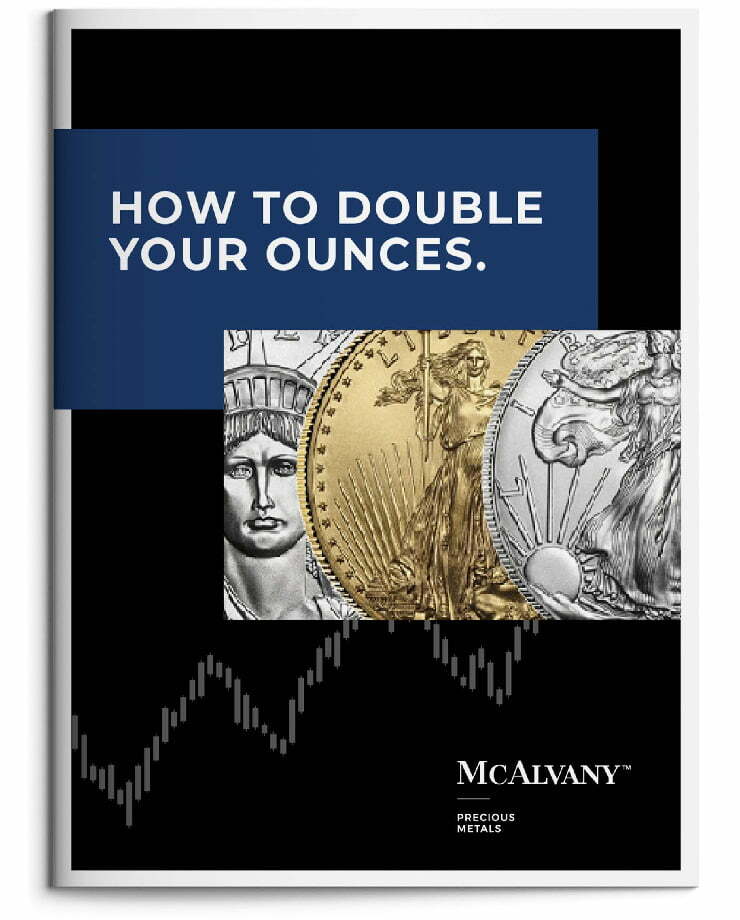Podcast: Play in new window
- 5 More Stealth Bombers Moved To The Middle East
- S&P Down 4.6% QTR, Gold Up 19% QTR
- DOW/Gold Ratio Removes Emotion From Allocation Decisions
“Months ago, this is what we were talking about. The leaders out of the 2022 decline, the ones that have recovered fastest, there was a narrative supporting that recovery through ’23 and 2024: tech-dominant, AI-dominant, crypto-dominant. And they are now the leaders on the downside. In speaking with Wall Street firms, there is a hope that the worst is behind us already, and I’m not so sure.” —David McAlvany
* * *
Kevin: Welcome to the McAlvany Weekly Commentary. I’m Kevin Orrick, along with David McAlvany.
Actually, Dave, I should say welcome to Liberation Day, American Liberation Day.
David: There we go. We’ll see what we’re being liberated from and what the cost of liberation is. In every battle, there’s collateral damage. Let’s see what that looks like.
Kevin: Well, gold, over 3,000, over 3,100 is like, all right, well, then there is a cost to liberation.
David: Yeah. Spot gold traded to $3,145 to close out the month of March, and of course, closing out the quarter. The latest figures on investor interest, which had turned higher in February—of course that was following weak purchases in December and January—they were consistently high on the demand side in the first three weeks of March as well. So, full March numbers are still pending tabulation. February, as we mentioned, slight revision to what I said last week, 72 tons of ETF investor demand in North America. Again, first couple of weeks of March, 72 tons. First three weeks of March, this time stretched globally with one single day seeing 23.7 tons of demand.
For March, it was Europe pulling the gold market higher. Asia, North America, demand was softer. The critical factors on investor minds, here we are this week—any surprise?—geopolitics, trade wars, barely separable.
So, quarter-end gains in precious metals-related shares helped to push our returns in the asset management side to double digits. Hard assets in general, they’re working in contrast to financial assets, which remain under pressure. So, we expect tempering of that uptrend. We love it, but all good things do come to a pause, at least, but only a short respite. Hard assets are to date not succumbing to pressure in equities. Let’s see if they can stand up to deleveraging the way they already have stood up and outperformed broad market derisking.
Kevin: I was thinking about it the other day, Dave, what if you had to tell a story and speak to any culture going back thousands of years? You’d have to simplify. You’d have to simplify the language and bring up things that they would recognize. Gold, the gold story, you could tell the gold/uncertainty story going back 4,000 years. I mean, the old Sumerian and Babylonian writings were weighing the price of things relative to gold, and a lot of times it had to do with uncertainty.
David: Well, absolutely. Whether it was in ancient Lydia, fast-forward to more contemporary, Florence or even post-World War II, what does the world monetary system look like and do we use gold? Do we not use gold?
Uncertainty reigns. And the feelings of investor concern, I think they’re more acute coming into Liberation Day, April 2nd. Market behavior, it feels a little bit like this: A punted football just getting ready to hit the ground. The bounce could be relief. There’s rallies in risk assets, a correction in gold, possible outcomes. But on the other hand, trade tensions ease. And those are, of course, possible outcomes if you have trade tensions which ease.
But the flip side is also true. Equity indices are right now on a knife’s edge. They’ve been trading below the 200-day moving average. This is the NDX, this is the S&P, this is the Dow, rallying back to test those numbers from below, and uniformly failing to muster enough energy to retake those technical thresholds.
You might think of Wednesday as the last day to get the rally work done. And if negative sentiment further materializes this week and into next, we’re close to taking out very critical levels. March 11th, March 13th, index lows. And below that, below what we saw just a few weeks ago, the market’s next support is another 10 to 12% lower. And that puts you in bear market territory for sure.
So, a break of the March lows, just to state it again, may trigger de-leveraging, for which we are on high alert. Everybody knows. I think looking back to the global financial crisis, looking more recently at August 5th last year, correlations across assets tend to converge when you’ve got major de-leveraging.
So, if you’re not cash-heavy yet, you should be. A weakness in the high-yield bond markets and the leveraged loan markets are becoming problematic. And if that now migrates to investment-grade debt as well, I think you’ve got further confirmation that real trouble is on our hands.
Kevin: My wife watches the price of gold a little bit just to see how her husband’s day is going. And I came home the other day and I said, “Did you see gold? It was up almost $30.” And silver, platinum, palladium, rhodium, they were all down. And we both knew, because after 38 years of coming home and talking about it, that was probably geopolitical. That was the day that we found out that they were moving five more stealth bombers into the Middle East.
David: Yeah. I mean, in recent weeks, gold’s taken on a life of its own. It’s moving, and it’s moving higher, and it’s moving higher again. And it absolutely reflects the unresolved trade tensions, the sabre-rattling in the Middle East, the growing pressures in US and Chinese relations over Taiwan. Diego Garcia in the last 10 days has become home to five stealth bombers, with some reports of another two on the way. There are only seven in the fleet, total, so, it is a show of force for sure. And Tehran will either be dealing with another Trump bluff or tempting fate with being blown back into the stone ages.
Kevin: And I think that’s where the uncertainty comes. We don’t really know, because the art of the deal is going on all over the place. And it could be a bluff, but if it’s not a bluff, boy, what kind of signal does that send to the rest of the world?
David: No, I mean, it’s one thing to say you’re fired, it’s another thing to say you’re vaporized.
Kevin: True.
David: I mean, it’s a little bit different than The Apprentice. So, bunker busters in Tehran would certainly increase the global concern over tariffs. And to me, it’s a little bit like the poker player. You think he’s bluffing, he’s seeming to bluff, and then all of a sudden he lays out a royal flush and everybody at the table thinks differently about how they previously read the room. “Not bluffing, Mr. Trump?” So, the negotiating balance shifts dramatically with military action in Iran.
Kevin: Yeah. So, actually, that would bring some certainty, wouldn’t it? I mean, if something happened in Iran and we did send bombs in there, we would cure one of the uncertainties. But let’s go back to the stock market for a moment, because weighed in dollars, the stock market’s down right now. Weighed in gold, it’s down a lot more.
David: Yeah. The S&P ended the quarter down 4.6%. The Nasdaq 100 had its worst quarter in three years, down 8.3%. Bitcoin was off over 10% for the quarter—that’s a year-to-date figure. Gold finished the quarter up 19%. Silver, up 17.9.
So, the contrast between hard assets and financials played out dramatically in the first quarter. And I think there’s notable commentary— Silver has room to close the ratio performance gap, the gold/silver ratio performance gap, even though in nominal terms it was neck and neck with gold for much of the last three months. To my mind, do these double-digit moves in the case of gold—I think you could argue it’s in a rather overbought place—does that get worked off in a sideways consolidation, taking some time? Or does a consolidation get packed into a shorter timeframe, but with a more dramatic price move lower? Again, taking a lot less time.
Kevin: Or there’d be a third way where you said gold has a life of its own. Could we just see continued momentum to the upside?
David: Yeah. I mean, the third way, continued momentum to the upside driven by more uncertainty over trade and geopolitical relations, that’s certainly a possibility. It makes sense for gold to correct. It certainly doesn’t have to. I think the longer term trend is pretty compelling. But here at this point, given the unknowns, anything can happen.
Kevin: Right.
David: One quantifiable fact: I think investors are not heavily allocated to metals, and not heavily allocated to the precious metals miners. We are, at current levels, around 12% away from the inflation-adjusted all-time highs for gold. That’s roughly 3,400 and change.
In one sense, this is expensive. Investor traffic, quite interestingly, to date has been very light. While it’s hard for most investors to imagine yet higher prices in the gold market, the allocation to physical metals is nowhere near peak levels. Last time we were at the all-time highs—go back several decades, 850 being the high (again, we’re talking about the inflation-adjusted equivalent being 3,400 today)—you had a crowded space. You had virtual panic in the equity markets. You had virtual panic in the realm of geopolitics, and retail investors were going crazy for anything gold and silver.
Kevin: I remember when your dad would tell the story. I wasn’t here yet. You’re talking ’79, ’80, when gold ran up to 850 bucks. But your dad, your mom, and I think one other trader were taking millions of dollars worth of business. This is in 1980 dollars. How many trades would your mom process in a day? Was it over 100?
David: Well, so they would write down the trades during market hours when they could establish prices, and then they would have to come back and finish completing writing the details on those trades. And they would sometimes be around until 9:00, 10:00, even midnight. And it took five to six hours just to finish the paperwork on transactions.
Kevin: Oh, yeah. It was a relatively small operation back then. And I mean, they were just overwhelmed with retail business.
David: So, again, we look at, and we say, okay, well, central banks got us this far, and yet retail is still largely absent. I think investors, at this point, if you’re looking at quarterly performance, the S&P, the Dow, the Nasdaq, the high flyers, maybe now they’re considering rebalancing. You look at the Gold Miners Index, it’s up by 30% year to date. It’s an attractive way to play gold. Relative to gold, there are still multiples of growth in that space. Relative to the S&P, it’s even more attractive. If you look back at previous moves in gold compared to the S&P, it leaves open the possibility of five times outperformance—conservatively—again, relative to your traditional allocations.
The Dow/gold ratio, again similar to the S&P and gold, the Dow/gold ratio is accelerating its trend to lower levels— where, from one vantage point, the Dow buys less ounces. Or seen the other way, gold buys more shares. 13.3:1 is where we started this week. I wouldn’t surprised to see 8.5:1 on the ratio this year. That equates to a correction in the Dow off of its peak levels, not current levels, but off of its peak levels of between 25 and 30%, and gold stretching to 35 in the short term.
Kevin: Okay. So, let’s go back and look at a little history, because we were talking about ’79 and ’80 in your family’s company. If McAlvany Wealth Management would have existed at that time, people could’ve shifted out of some of that gold at a one-to-one ratio to the Dow. That would’ve been an amazing run—a 40-fold run, Dave—from that point forward, because from 1980 you went from one-to-one to the year 2000 when it was over 40.
David: And that’s exactly what Richard Rainwater did for the Bass Brothers. Coming out of hard assets at the end of a cyclical peak in hard assets, moving to cash for a short period of time, and reallocating about 18 months later out of Treasuries, out of cash, into equities. And capturing what was the low cost basis of a great bull run in equities starting in 1982, stretching all the way to the year 2000. And takes the perspicacity of somebody like Richard Rainwater to say, “We don’t have to be subject to the old adages.” Stocks for the long run certainly makes sense, but the idea of buy and hold without any recognition of the macro environment, that can be deadly.
And you look at the Bass Brothers’ fortune, it was made in hard assets, but there was no permanent marriage to assets when they had run their full course. You diminish, you shrink back, you take gains, you reallocate.
It’s one of the reasons we created the wealth management group back in 2008, to say, let’s see where gold goes in its ultimate stretch to higher levels. And there’ll always be room for an insurance component within a portfolio, but there’s going to be significant gains that need reallocation. And to be able to do that, I think, makes some sense.
Kevin: Well, I think it’s time for people to actually start talking that way, because we’ve watched that Dow/gold ratio drop from 42 to one down to 25, down to 20. Just a month ago, we were 15 to one, now we’re 13 to one.
David: During the depths of the global financial crisis, we got as low as six to one, and then it rallied back to about 22. So, the most recent highs of 22, shrinking to 15, it hung out around 15 for a good two, three years. And now it’s picking up some steam on the downside, which again, you look at those two pieces when you’re doing a ratio, you’ve got a numerator, denominator. You can have both of them move, and the moves happen more rapidly, or you can have one only. And maybe it’s the Dow moving to the downside. Maybe it’s the Dow and gold moving to the downside, but the Dow moving more rapidly. It doesn’t matter. The math is the math, and that’s what’s most compelling. I don’t care about $3,000 gold or $5,000 gold, or $2,000 gold. I care about the purchasing power of the metal in other terms.
Kevin: You’re looking for the long-term picture.
David: Yeah. So, in the second quarter—bringing things to the present tense—will we see supportive rotation in the second quarter or consolidation of gains? I think the long-term picture is one—for the hard assets—of relative outperformance. I’m talking about the physical metals market, also the miners and the other things that we invest in on the asset management side.
If you haven’t reached out to our team, I would. We will be doing a special presentation at the end of the month, next 30 days, exploring your hard asset strategy. If you want to be on that call, registration or information will be provided. We’re still a month out on that, so nothing right away.
Kevin: A couple of years ago we would call it the FAANGs. The FAANGs were where the concentrated trade was. Just a few stocks were making up the majority of the trading. In 2022, we saw that those FAANGs really got hit. Now they’re called the Mag 7. I’m sure they’ll come by other names. But really, it’s like a very, very tiny concentrated market that tells us the direction of the overall whole. And so, what’s happening right now, I mean, AI, tech, it seems to be guiding us on the downside, not on the up.
David: Yeah. I mean, months ago this is what we were talking about. The leaders out of the 2022 decline, the ones that recovered fastest, there was a narrative supporting that recovery through 2023 and 2024: tech-dominant, AI-dominant, crypto-dominant. And they are now the leaders on the downside.
In speaking with Wall Street firms, there is a hope that the worst is behind us already, and I’m not so sure. Interesting remarks from Howard Marks. He takes aim at valuations in his most recent missive, suggesting that valuations are way too high. And you get into periods of high valuation, and that leads to longer periods of return in equities broadly over the next decade, which are sub-optimal. In his view, should average between plus two or minus 2% annual returns for the next decade.
Kevin: And he’s using Tobin’s Q, Buffett ratio, price earnings. What’s he using for valuations?
David: Yeah, using price earnings. Using standard price earnings and saying, look, if you’re into the low to mid-twenties, you’re going to suffer. And of course, we like the Shiller P/E better because it takes some of the volatility that corporate execs will sometimes introduce for compensation purposes and remuneration purposes—it just smooths that out.
So, for us, Shiller P/E, Tobin’s Q, Buffett ratio. For Howard Marks, the standard P/E. This is what we’ve been saying, and it’s nice to find some support in that. Sitting in short-term Treasuries with low volatility, if you just think about this, if your expected returns of the next decade are either plus two or minus 2%, being in the S&P as an example. Plus two, minus two.
Kevin: That’s not very attractive.
David: Sitting in short-term Treasuries with low volatility, that provides you with the opportunity to outperform the equity market by a wide margin, 4%, with a lot less heartburn along the way. In recent quarters, I mean you go back through all of 2024, our emphasis has been on raising cash. And I think we’ve been pretty vocal about that through Q4 last year, Q1 so far this year, adding to metals, metals-related investments. That still looks like a smart move to us.
Kevin: Cash and gold, baby. Cash and gold.
David: But Jim Bianco makes an excellent case for the risk-adjusted returns in short-term Treasuries—which, to date, if you think about how we hold our cash, it’s actually our largest allocation, short-term Treasuries. Bullish on the hard asset thesis, don’t get me wrong, but we have our own version of the 60/40 portfolio. It’s not 60% general equities, 40% bonds. Quite different. Our version is 60% hard assets, 40% Treasuries. And under the right circumstances, it might be 90/10. We’ll be more fully invested. But Treasuries to us are the critical factor in navigating market volatility and providing optionality for any weakness that bleeds over into hard assets. There’s nothing that says hard assets are immune to market volatility.
Even if they’ve got fabulous fundamentals supportive, we still want to be able to take advantage of any weakness, thus we’ve got a healthy cash position. That may not transpire. But as fiduciaries, we see the risks in the current market backdrop as extraordinary. We also see the rewards in hard assets as equally extraordinary. But frankly, to be fully allocated would suggest we know more than we actually do about how these trade war and geopolitical conflicts resolve themselves. So, we take it a day at a time. And this week, to be honest, it’s an extraordinary set of days.
Kevin: Yeah. We just got out of our meeting with Morgan Lewis this morning. And he was talking about the sentiments and the indexes that are pointing to recession right now.
David: University of Michigan surveys, the conference board surveys, the CFO surveys, the CEO surveys—uniformly sour. 60% of CFOs see a recession in the second half of 2025. Another 15% on top of that see that materializing in 2026. CEO ratings of current business conditions, it fell from the December level of 7.0. This is on a 10 point scale, so we were at 7.0 in December. And March, 4.99.
Kevin: That is a big drop.
David: It’s the weakest reading in 13 years. So, the current sample, I mean, to be honest, if you listen to this Commentary, this isn’t a surprise. It reflects the executive actions that we’ve been highlighting for the last 90 to 120 days.
Kevin: These executives have been selling their own shares.
David: Exactly.
Kevin: You’ve been bringing up insider trading.
David: Yeah. Well, not insider trading, insider sells.
Kevin: I didn’t mean that. That’s right. Insider selling.
David: Insider selling. Sometimes it’s on news that they’re sensitive to. Maybe it’s just being close enough to the economy to see the trend and knowing that their price trajectory is not going to be as well-supported.
Kevin: Right. But they have to report that. If you’re a CEO, you have to report when you’re selling your own company shares.
David: Yeah. So, increased insider selling of corporate equities, those actions always are worth paying attention to. Morgan, our co-portfolio manager in the hard asset strategy, noted this over the weekend. Just as we had the period of globalization from 1846 to 1914, and it ended with a collapse in trade in capital flows, very much favoring gold, favoring hard assets relative to financial assets, the unwind of globalization 2.0 seems to be favoring the hard assets again, relative to financial assets. Trump policies are bringing into focus changes that were already afoot. And it depends on what timeframe you want to look at. We’ve got the on-shoring and friend-shoring from the post-COVID period.
If you go back to previous conversations we’ve had with Harold James, as an example, who wrote the book The End of Globalization. Well, that book is now 20 years old. And he’s had some amazingly important insights into what it looks like to come to the end of a period like this. So, this is not something that’s been happening overnight, and it certainly is not attributable solely to Trump. So, again, the on-shoring and friend-shoring from the post-COVID period. Now on a more accelerated timeframe, we’ve got the disruption of market expectations.
Kevin: Well, there’s a model change, too. We talked about this last week. You have to sometimes change your frame of reference when the environment changes.
David: And yet there’s not a recognition that the model has changed. There’s not a recognition that the paradigm is shifting, so you’ve got investors over-allocated to themes that previously worked. And they’re facing fresh challenges in a new paradigm. So, traditional allocations, the old rules no longer apply. Morgan loves this quote. He references it pretty routinely. Merrill Lynch legend Bob Farrell, “In a shift of secular or long-term significance, the markets will be adapting to a new set of rules while most market participants will still play by the old rules.”
Kevin: Well, and that’s the key, “While most market participants will be playing by the old rules.” Your dad has always said the majority, the crowd’s always wrong, but somebody must be right because look at ETF flows into gold right now.
David: Well, just pausing to take that in. We have a monumental change afoot—actually changes—which are not being recognized as such. The old rules are still being used by financial advisors and allocators of capital in the hopes that no secular shift is unfolding. And I think you’re right. The ETF flows to gold in February, outperformance of hard assets in Q1, I think that’s going to begin to entice a rotation, if not on the basis of a regime change recognition, at least on the basis of pragmatics and performance.
So, risk management and active engagement with portfolio administration is critical, particularly in a period like this where the tides of liquidity are ebbing and flowing. And when they begin to flow out, it’s even more critical. Arguably, such tight controls can be ignored when liquidity is abundant and all investment themes are working. Doesn’t matter. I mean, you can just open the Wall Street Journal, pick a stock, you’re probably going to do all right.
Kevin: But you can do anything with liquidity. What happens if it dries up?
David: Shift liquidity from abundance to scarcity, and asset class performance begins to differentiate dramatically. So, hope is not a strategy. I did a call with a Wall Street money manager earlier this week. And the conclusion was, on their part, our bear market correction is already over. It was past time to course correct allocations given the sell-off in AI and crypto and the semiconductors and the host of high-flying names. In their view, there was no need to do anything but wait for the recovery.
Kevin: And stop listening to Bessent on the word detox because what he’s assuming, and I hate to say this, but if he thinks the bear market in stocks is over, he probably assumes that the government’s going to continue to do what they’ve done for decades. But Bessent has already said detox.
David: These guys were young enough to really confuse what detox is after a long night of drinking, assuming that it’ll be over in a 24- to 48-hour period. The detox that Bessent is talking about is something that has a lingering effect, maybe quarters, maybe even years. We’ll see.
So, if you connect the dots from a weakening consumer and a diminishment in the wealth effect, spending coming from the top 10% of income earners. We talked about how close to 50% of all consumption is coming from the top 10% of income earners. If you combine those things and then look at the CFO sampling we mentioned a moment ago, suggestive of a recession late in 2025, for Wall Street asset managers that should be like a cold plunge. Not like a cold shower, but a cold plunge. But it’s not.
I mean, even in the face of trade wars and the increasing probability of hot wars, the view is still held that you should remain over-allocated to the S&P, over-allocated to Nasdaq and your other traditional indices. Can’t time the market, I was told that again this Monday. Can’t time the market. Can’t time the market. But can you not infer from valuations being in the highest decile, that taking a little off the table might be prudent? No. No. The shift of secular or long-term significance is not even recognized, and so the answer is no, because you’re going to miss out on upside opportunity.
So, client assets are at risk in large part because intelligent and well-meaning asset allocators have no macro view. Having a framework that takes into account an evolving market backdrop does take you in a different direction. We discussed frameworks, we discussed models last week, and we discussed how imperfect they are. Imperfect is the best way to describe any model. Incomplete.
So, what does that require of us as investors? Flexibility in mental modeling, flexibility in constructing the models that we use to try to understand the world, I think that’s a prerequisite for navigating life, certainly the markets as well.
Kevin: I would challenge our listeners, too. One of the things that I noticed going through the 1987 crash, which was a surprise to virtually all the asset managers, going through the 2000 crash of the Nasdaq, going through the 2008 crash, these guys always say the same thing, “You can’t time the market.” But if you really look at the age, this is the challenge that I would throw out to our listeners. Look at the age of the guy giving you advice, and ask him how many crashes he’s seen and what he does when it happens.
David: I think of Peter Palmedo, who was at Morgan Stanley trading derivatives, and convinced his bosses— Well, he tried to convince his bosses to short the market, and complex models, but nobody would buy in. He was thinking problems with portfolio insurance and what happens when portfolio insurance gets unwound. And they’re like, “No, no, no, no. Peter, that’s not how it works. Thank you.” Patted him on the head and sent him back to his corner with a dunce cap.
Well, I mean, of his class, he was one of the few who retired after shorting the market in 1987. And interestingly enough, runs a hedge fund, institutional only money, in gold shares.
Kevin: Right now?
David: Right now.
Kevin: Probably a little cash and gold shares.
David: Tell Peter you can’t time the market. He made his fortune timing the market. And so people who have not been around, I think that’s the easiest excuse for not fully engaging. Again, going back to Howard Marks, going back even further to a guy who’s not even around anymore, John Templeton. How is it that John Templeton outperformed the S&P by five to 10% every year for the duration of his money management career?
Kevin: He probably watched valuations, like you said with Marks.
David: Of course. Of course. So, we don’t know with certainty how this year’s going to unfold, but we have probability, and we have history as a rough guide for how human emotions shift and define the sentiment in the markets for better or for worse. Circumstances are such right now that we can reasonably assume the over-leveraged financial operators in equities, the over-leveraged operators in private equity, the over-leveraged operators in private credit, they’ve tied themselves to the mast and they are unwilling to course correct. They can’t see things differently because they’ve already committed the capital. And frankly, there’s a lot of it that’s not liquid. If they wanted to course correct, they can’t. Too many bullish assumptions have been imputed to their business models to do anything but try and ride out whatever materializes.
Kevin: You were in Washington D.C. this weekend, and I know you met with some pretty sharp folks. I mean, these were not just the average run-of-the-mill type of person who’s out investing. What are they seeing? Do they understand the model that you’re trying to talk about right now, I mean, the prognosis of a model change worldwide?
David: First of all, cherry blossoms. Couldn’t have timed it better.
Kevin: It’s beautiful this time of year, the cherry blossoms.
David: Oh, yeah. And there are risks that I’m willing to take. One of them is the electric scooter up and down the mall. Absolutely a riot.
Kevin: With a cigar in your mouth?
David: No, not that I’ll admit to. But just a beautiful, beautiful place that time of year, and amazing people, really thoughtful people trying to figure out how to navigate life and legacy and business decisions, and expanding businesses, contracting, selling, reallocating capital.
Amongst this crowd, there’s a number of real estate operators. And there appeared scant scenario analysis. Very little planning done to assess the implications of tightening liquidity, slowing of deal flow. In fact, there was one operator, kind of stood out from the crowd. Self-storage space, in tune with a dramatically shifting credit environment. I thought, okay, this is somebody who gets the context and is sussing out both risk and reward. That’s somebody I could give money to.
But someone who’s only focused on the reward side, irrespective of risk, those are the people who are going to surprise you on the downside in terms of performance, in terms of not able to navigate an increasingly complex and complicated market environment.
So, one of the six real estate operators that were there, a great opportunity to mix with them. But amongst the majority, the hopeful expectation of declining rates, a supportive backdrop for lending and investment. And I hope I’m wrong, but there is a larger story unfolding. The Bank of International Settlements, again, going back to Morgan’s comments, as far back as 2019, was discussing the end of globalization 2.0.
So, again, this is not Trump and this week and Liberation Day, this is a process that’s been unfolding for two decades, more acutely since just prior to COVID. And now we have something in real time happening quite quickly with the Trump administration.
So, the BIS 2019 discussing the end of globalization 2.0, and with that comes a radically different investment backdrop. If the equity markets, just as an example, hit the skids this year, there will be direct and immediate implications for just about every other asset class. And I’m reminded of the phone call I had on Monday. And the question was asked, what do we think about alternatives? Should we be allocating to alternatives? By that they meant private credit and private equity.
There’s just as many implications, negative implications for alts, hedge funds, private equity, private credit. The only advantage you gain from alternative asset classes like those is a reporting lag of as much as six months. So, you could actually see an extension of complacency for those investing in alternatives, maybe even into 2026.
Kevin: Do you sense the subprime feel that we had back in 2005 and ’06?
David: Of course. Yeah, no, it’s just migrated. Subprime lending was the rage. Mortgage-backed security space, that was 2005, 2006, and up to 2007. This time, subprime is migrated from the pedestrian mortgage-backed security market to the patrician realm of alts.
So, sophisticated investors have placed an inordinate trust in the complex financial structures that only Wall Street bankers can create. They will continue to believe for an extra six months that their portfolios are bulletproof and far less volatile, duped by marked-to-model fabrications of stability.
This is a really interesting period of time. 2025 is a year of volatility. We’ve said that from the outset, first week of the year. It’s one of dramatic shifts which will call into question the assumptions that drove pro forma expectations, ultimately set investors up for disappointment.
Kevin: Well, you said hope is not a strategy, and you’re right. I think of guys who are no longer with us, who had such an effect on us, Dave. Richard Russell, he would look at the Dow Theory and he used the numbers. And there were times when he hoped against the numbers. He would actually say it in his newsletter. He’d say, “You know what? I hope this is wrong, but I’m maneuvering because the system has worked up to this point.” And so, to remove emotion, I mean, you bring up the Dow/gold ratio, that’s got to be one of the most useful tools to remove emotion or hope or despair, basically, from decision making.
David: It’s been a guiding light for most of my professional career. It was one of the things that made me rethink staying and creating a career at Morgan Stanley, looking in those first couple of years at Morgan Stanley with the Dow/gold ratio around 40:1, and seeing that I was just on the wrong side. I was at the wrong side of the trade.
And so, for the years that I was there, I focused on tax-free municipal bonds to be able to get a taxable equivalent yield of 8.5, 9% in a triple-A GO bond. I mean, that’s what I did. I went to business owners and I said, “You control your risk by controlling your business. Don’t take any outside risk with your capital. Don’t take any big losses. You’ve got a great business. You’ve got a great income. Why are you giving money to a broker who’s taking more risk, and you can’t quantify it and you can’t control it?”
Kevin: Well, and I remember those conversations, Dave, because you would call the office back here and we would talk. At lunchtime, remember you’d say, “Are you reading any books?” And we’d talk about books we’re reading. But you were looking at the numbers, just like what we’re talking about.
David: And the market has shifted. I’m not suggesting that someone go look for tax-free muni bonds and you’ll be hard-pressed to find anything that—
Kevin: No, but at the time—
David: At the time.
Kevin: —you saw that you were on the wrong side of the stock part of the trade.
David: Right. And the only place to hang out, particularly working with business owners—that was my focus—was helping them appreciate that they’ve got a good thing going and they don’t need to put any more risk into their total net worth. They don’t need to. Their businesses are great, so just maintain and be as tax-efficient as possible. That was kind of where I came in. 2003, I started working with our precious metals business. And came in, and then my dad handed the reins over in 2008, five years later, as he sort of galloped off into the sunset.
Kevin: Remember, we sat at Seasons over a glass of wine. You said, “Let’s go to Seasons because they have a great wine cellar.” And we sat over a glass of wine and you said something that I just never thought I’d hear. You said, “I think I’m coming back here to work on the gold side of things.”
David: Yeah. That was the winter of 2002. And by March of 2003 we had made the move. Well, the Dow/gold ratio has moved from 43:1. In the global financial crisis, it reached a low of 6:1, rallied to 22, and is now working its way again lower. And what you need to see that ratio move into the single digits are a series of catalysts. Do we have those catalysts this week?
When you think about the numerator and the denominator, it doesn’t matter which is moving. And sometimes both move. So, we could have the Dow decline from 41,000 to 35,000. To 25,000. We could have gold stay flat. We could have gold go down, but go down less in percentage terms than the Dow. What we’re interested in with the ratio is the purchasing power of ounces to shares. And it gives you, as you described earlier, this dispassionate view of your allocations.
Where should you be and why? And is there a time to spend ounces for shares? Yeah. And I think for the farmer, there’s times to spend ounces for acres. If you have a particular insight into a particular market, it may not be the Dow. It may be some other asset class. That’s fine. Invest where you have an advantage. That is one of the key takeaways from John Templeton’s life. Invest in yourself. Invest where you have an advantage. For us, because we know the money management space and the gold space, that’s one of the reasons why this is so seamless for us.
* * *
You’ve been listening to the McAlvany Weekly Commentary. I’m Kevin Orrick, along with David McAlvany. You can find us at mcalvany.com and you can call us at 800-525-9556.
This has been the McAlvany Weekly Commentary. The views expressed should not be considered to be a solicitation or a recommendation for your investment portfolio. You should consult a professional financial advisor to assess your suitability for risk and investment. Join us again next week for a new edition of the McAlvany Weekly Commentary.
















